There is a lot of variety when it comes to geese in the state of Utah.
Some are migratory, while others stay year-round. They all have different diets and can be found in different parts of the state, find out all below!
What Geese Are in Utah?
There are six different types of geese in Utah.
- Canada Goose
- Snow Goose
- Ross’s Goose
- Cackling Goose
- Greater White-Fronted Goose
- Brant
There are also two species of swans in Utah – Tundra Swans and Trumpeter Swans.

Canada Goose


Canada Goose Sound
Scientific Name: Branta canadensis
Length: 30 to 43 in
Wingspan: 50–73 in
Weight: 5.7–14.3 lb
The Canada Goose is a large, well-known species of waterfowl noted for its distinctive appearance, familiar “honk,” and migratory behavior.
Appearance: Both male and female Canada Geese have a similar appearance, featuring a black head and neck with distinctive white patches on the cheeks and chin. The body is primarily brown with a lighter, often white, underbelly.
Diet: Canada Geese primarily feed on plant matter, including grasses, aquatic vegetation, and grains. They can often be seen grazing in parks, lawns, and fields, as well as dabbling in water bodies.
Reproduction: Canada Geese typically nest on the ground near water bodies, often on islands or other isolated areas to avoid predators. The female lays a clutch of about 4 to 6 eggs, which she incubates alone for around a month.
Snow Goose

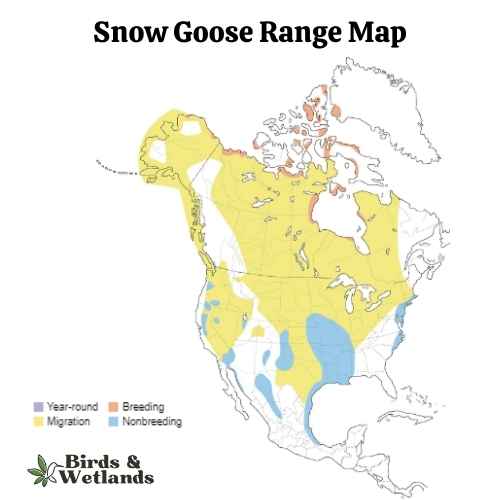
Snow Goose Sound
Scientific Name: Anser caerulescens
Length: 25 to 31 in
Wingspan: 53 to 65 in
Weight: 4.5 to 6.0
The Snow Goose is a large species of waterfowl known for its vibrant white plumage and significant migratory flights.
Appearance: True to their name, Snow Geese are predominantly white with black wingtips. They also have a pink bill, pink legs and feet. A color morph, known as the “Blue Goose,” displays a bluish-gray body with a white head, but is considered the same species.
Diet: Snow Geese primarily feed on plant matter, such as grasses, sedges, and small grains. They can often be seen in large flocks foraging in fields and marshes, and during migration and winter, they can cause considerable damage to agricultural fields due to their feeding habits.
Reproduction: Snow Geese typically nest on the tundra, near water bodies. The female builds the nest and lays a clutch of about 3 to 5 eggs, which she incubates alone for approximately three weeks. Once hatched, the goslings can feed themselves but stay with their parents for protection until they can fly.
Ross’s Goose
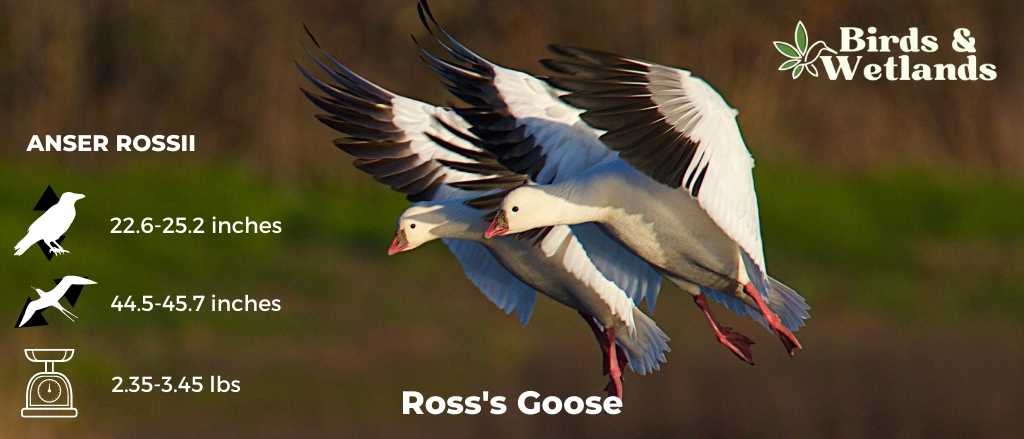
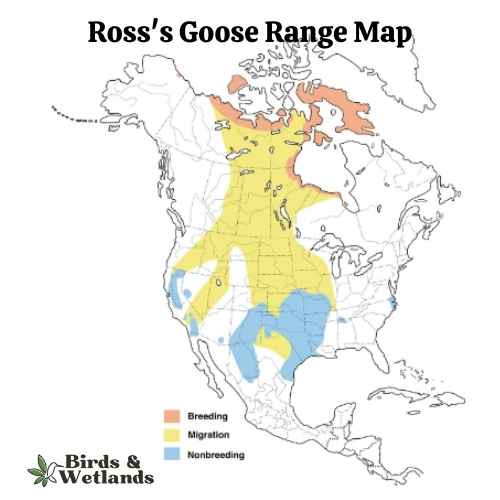
Listen
Scientific Name: Anser rossii
Length: 23.2-25.2
Wingspan: 44.5-45.7 in
Weight:42.3-55.3 oz
The Ross’s Goose is a small species of waterfowl often found in North America’s tundra and wetland habitats.
Appearance: Known for its compact size, the Ross’s Goose is mostly white with black wingtips. It features a short, stubby bill and a rounded head. One key identifying feature is the blueish gray base of its bill, which has a warty structure during the breeding season.
Diet: This goose feeds mainly on vegetation, including seeds, leaves, and roots of grasses and sedges. During winter and migration, they also consume grains and seeds from agricultural fields.
Reproduction: The Ross’s Goose nests on the ground, often in colonies. The female lays a clutch of 2 to 5 eggs which she incubates for around three weeks. The young geese, known as goslings, are precocial – they can walk, swim, and feed themselves shortly after hatching, although they stay with their parents until they learn to fly.
Cackling Goose
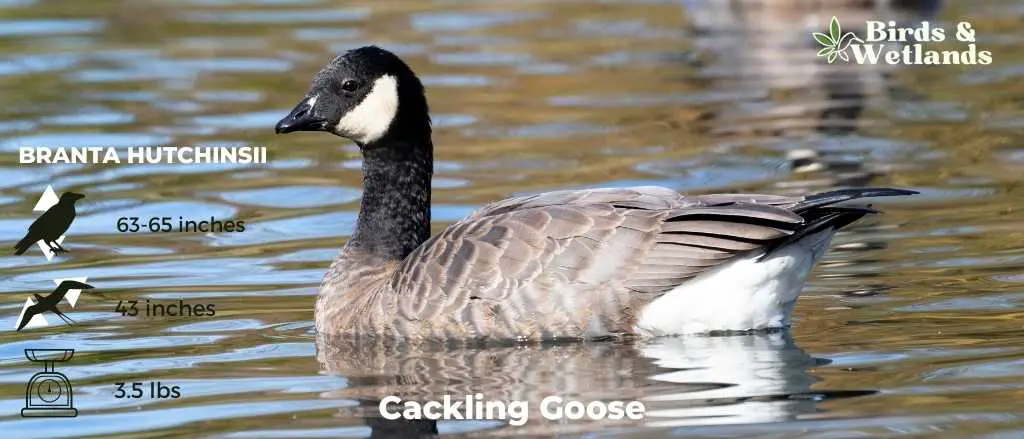
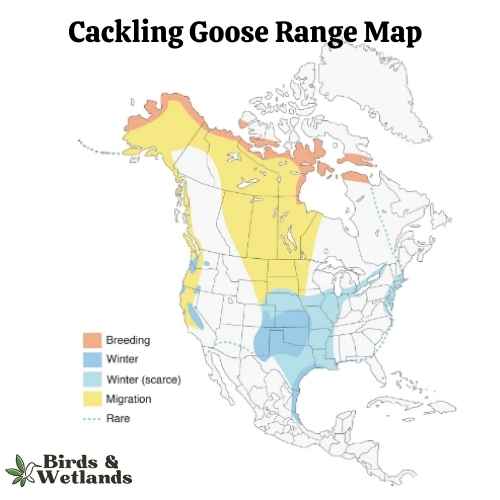
Listen
Scientific Name: Branta hutchinsii
Length: 24.8–25.6 in
Wingspan: 43-45.7 in
Weight:3.5 lbs
Cackling Geese are particularly known for their high-pitched, cackling calls, which is the source of their name. Despite their small size, these geese are renowned long-distance migrants, with some populations traveling thousands of miles between breeding and wintering grounds.
Appearance: With a similar color pattern to the larger Canada Goose, the Cackling Goose features a black head and neck, white chinstrap, light tan to cream chest, and brownish-grey body. One defining characteristic is its noticeably smaller size and stubbier neck compared to its larger counterparts.
Diet: Like many geese, the Cackling Goose’s diet mainly consists of plant matter. This includes grasses, seeds, and aquatic vegetation. They are often seen grazing on land or dabbling in shallow water.
Reproduction: Cackling Geese usually nest on the ground in elevated areas near water bodies, such as riverbanks or lakeshores. The female lays a clutch of 2 to 8 eggs and is responsible for incubation, while the male stands guard nearby. Incubation lasts for about a month.
Greater White-fronted Goose
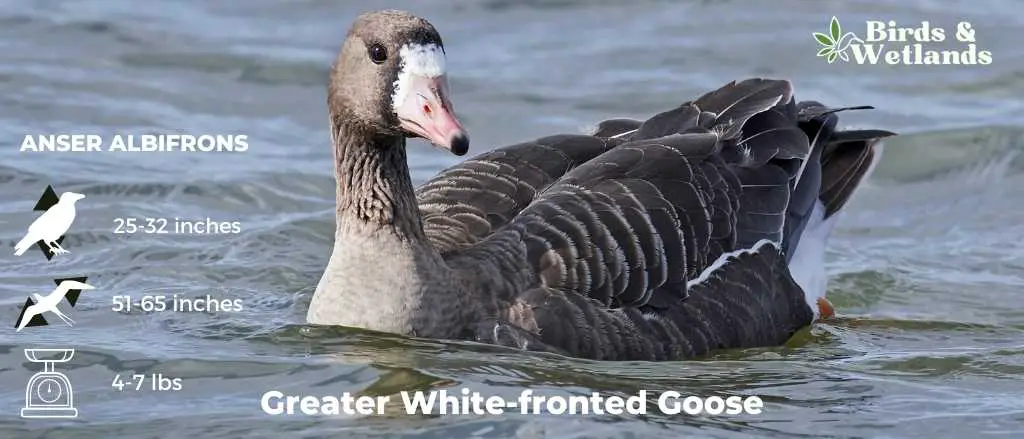

Listen
Scientific Name: Anser albifrons
Length: 25 to 31 in
Wingspan: 53 to 66 in
Weight: 3.3 to 6.6
The Greater White-fronted Goose is a medium to large waterfowl species, widely distributed across the Northern Hemisphere, particularly in North America.
Appearance: As the name suggests, these geese display a prominent white patch at the base of their bill. Their bodies are gray-brown, and their breasts are often marked with dark blotches. They possess a pinkish bill and orange legs and feet.
Diet: The Greater White-fronted Goose is a herbivore and feeds mainly on plant material. Its diet consists of grasses, sedges, grains, and berries. When wintering, these geese can often be found in agricultural fields, feasting on leftover grains and crops.
Reproduction: This species nests on the ground, often in areas with good visibility such as slopes or ridges. The female lays a clutch of 4 to 5 eggs, which she incubates for nearly a month. Once hatched, the young ones are taken care of by both parents until they are able to fly.
Brant

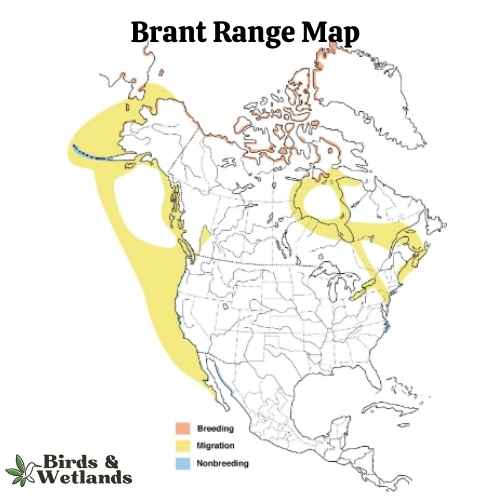
Listen
Scientific Name: Branta bernicla
Length: 22–26 in
Wingspan: 42–48 in
Weight: 1.9–4.9 lb
The Brant is a compact species of goose that is known for its striking appearance and interesting migratory patterns.
Appearance: The Brant is recognized for its dark, sooty color with a white crescent on the neck. The body is mostly black to dark gray, contrasting with the lighter underparts. Its small size, as compared to other geese, and short, stubby bill are other distinct features.
Diet: The Brant’s diet primarily consists of aquatic plants, especially eelgrass and sea lettuce. During the breeding season, they may also feed on grasses, sedges, and insects.
Reproduction: Brants typically breed in the high Arctic tundra. The female lays a clutch of 3 to 5 eggs in a ground nest, which she incubates for about a month.
Notably, Brants make an impressive long-distance migration every year. They spend their winters along both the east and west coasts of the United States and travel to the Arctic regions of Canada, Alaska, and even Russia to breed.
Where to Watch Geese in Utah?
One great place to watch snow geese in the state of Utah is Gunnison Bend Reservoir.
The reservoir is located in the western part of the state, and it is a prime breeding ground for snow geese.
Every year, thousands of snow geese migrate to the reservoir to nest and raise their young. Interestingly, snow geese don’t utilize the vast Bear River Bird Refuge, which is located in northern Utah, about an hour north of Salt Lake City, during their spring migration.
Are There Any Resident Flocks of Geese In Utah?
Canada geese are a common sight in Utah, and they can be found in a variety of habitats and the state offers them dense vegetation.
Farmington Bay and the Great Salt Lake are popular areas for geese, as the shallow water and plentiful food make ideal conditions for raising their young.
Farm fields and golf courses are also popular places for geese to live, as they provide plenty of open space and easy access to food.
In addition, many Utah lakes and ponds offer ideal habitats for Canada geese. The calm water and lack of predators make these bodies of water perfect for raising young and enjoying a quiet life. No matter where they end up, Canada geese are sure to find a welcoming home in Utah.
Geese Hunting in Utah
Hunting geese in Utah requires some specific gear. In addition to a hunting license and a Migratory Bird Harvest Information Program (HIP) number, you may be required to take a hunter education course by Utah Division of Wildlife Resources.
Can You Shoot a Goose in Utah?
Waterfowl hunting in Utah is a popular pastime, but there are some regulations that must be followed in order to ensure a safe and successful hunt.
One of the most important rules is that only a shotgun loaded with a nontoxic shot may be used.
This ensures that the ducks and geese that are shot will not be poisoned and will be safe to eat.
Another important regulation is the bag limit, which dictates how many birds may be taken in a single day.
Where Can I Hunt Geese in Utah?
Utah is a great state for hunting geese. There are many different spots that offer good opportunities for bagging a bird, but some places are better than others. Ogden Bay and Howard Slough are two of the best places to hunt geese in Utah.
Ogden Bay is a large body of water that is home to many different species of birds, including geese. The bay is located near Ogden, Utah, which makes it easy to get to.
Howard Slough is another excellent spot for hunting geese. This slough is located in northern Utah and is known for its large population of birds. It is also a beautiful place, with plenty of open space to walk around in and enjoy the scenery.
Is There a Goose Hunting Season in Utah?
For those looking to hunt geese in the state of Utah, it is important to know that there is a hunting season. October to March are the months when geese are typically hunted in Utah.
Conclusion on geese in the state of Utah
Utah is a great place for geese. They can find plenty of food and shelter here. There are also many different types of geese that live in the state, which means there is a lot of variety when it comes to these birds. If you want to see some amazing geese, come to Utah!

